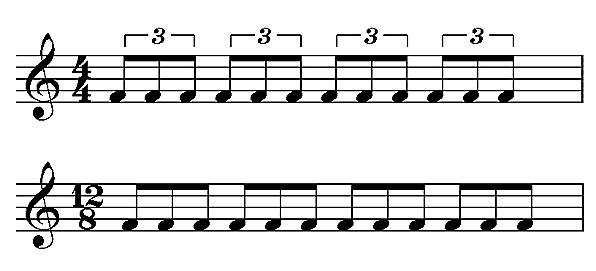In
Compound Time signatures, the beat is broken down into
3-part rhythms.
The top number is always divisible by 3, with the exception when the top number is 3.
Also, each beat is divided into 3 components, creating a 1 - 2 - 3 pulse.
So
Compound Time is any meter whose basic
note division breaks into groups of three.
So you automatically know you are not in simple time if there is a number
8 at the bottom of your time signature.
An 8 to mark simple time would be pointless. Think about it.
So, when you see an
8 as the bottom number of your time signature, you know that your eighth notes should be grouped together in groups of
three instead of two!
Let us take an example and use
6/8 
and here you have six beats in each bar with quavers, which divides into three groups of two eighth-notes,
while in 9/8 ( 9 beats in each bar of quavers) you have three groups of three, eighth notes,

and 12/8 (12 beats in each bar of quavers) has four groups of three eighth notes.

Technically, to get a
compound time sound, composers could use a simple time signature and then mark all of the main beat subdivisions in triplets—making a duple division into a triple—throughout an entire piece to get the same effect.

However, using triplets throughout a piece, as you can well imagine, to get a compound time sound, would appear quite messy on the score, not to mention how extremely cluttered it would be on the page.
Playing it would also be a strain on your eyes, your concentration levels and your brain power.
But be aware that the use of 12/8 and the 4/4 using triplets, will, to the listener, sound exactly the same, as the previous image clearly shows.
Anyway, using triplets instead, would be very confusing for performers.
Interestingly, from a historical point of view, even though it has been more common to see a simple time signature with the duple (i.e. split in two) divisions in Western music during the past five or six centuries, it was actually compound time which developed and was notated first!
Because Western music notation developed alongside church music, much of the underlying theory surrounding music had a theological basis.
For time signatures, the most common subdivision was in compound or triple divisions to relate musical time, being three in one, similar to the Christian Trinity of the Father, the Son, and the Holy Ghost.
So to summarise, what we have looked earlier about Compound Time, where the beat is divided into three.
Some other examples include:
6/8 there are 6 quavers per bar, with those 6 quavers being grouped in two groups of three. Hence it is called compound duple time.
6/4 is also called compound duple time, because there are 6 crotchets per bar, with those 6 crotchets being grouped in two sets of three.
9/8 there are 9 quavers per bar, grouped in three groups of three. Hence it is called compound triple time.
12/8 there are 12 quavers per bar, grouped in four groups of three. Hence it is called compound quadruple time.
In the next Reply, we have a link to another relevant Time Signature, You Tube example.
Peter